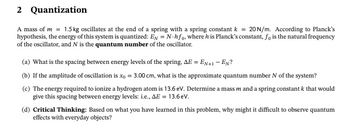Question

Transcribed Image Text:2
Quantization
A mass of m= 1.5 kg oscillates at the end of a spring with a spring constant k = 20 N/m. According to Planck's
hypothesis, the energy of this system is quantized: EN = N-hfo, where his Planck's constant, fo is the natural frequency
of the oscillator, and N is the quantum number of the oscillator.
(a) What is the spacing between energy levels of the spring, AE = EN+1-EN?
(b) If the amplitude of oscillation is xo = 3.00 cm, what is the approximate quantum number N of the system?
(c) The energy required to ionize a hydrogen atom is 13.6 eV. Determine a mass m and a spring constant k that would
give this spacing between energy levels: i.e., AE = 13.6 eV.
(d) Critical Thinking: Based on what you have learned in this problem, why might it difficult to observe quantum
effects with everyday objects?
Expert Solution
This question has been solved!
Explore an expertly crafted, step-by-step solution for a thorough understanding of key concepts.
Step by stepSolved in 6 steps

Knowledge Booster
Similar questions
- Given this quantum state: ¥(r,0,0) = R(r)(√₂Y+Y¹-Y₂²), a) measured: |Z|² , find possible outcomes, corresponding probabilities and the average value b) repeat the same but instead with measured say Lz c) If you had first measured Lz to be planck's constant, and then measured |Z|² what can be said about the result of |Z|² ?arrow_forwardLight of frequency 12x1015 Hz shines on to clean caesium metal. What is the maximum kinetic energy of the electrons emitted ? The work function of caesium is 1.5 x 10-19 J and the Planck constant h = 6.63 x 10-34 J s. Round off the answer to 2 decimal places and write answers as power of 10.arrow_forwardPlanck’s constant has the value h = 6.626 × 10–34 joule-seconds (J-s), and the speed of light is c = 3 × 108 m/s. Using these values, calculate the wavelength carried by photons emitted with an energy of 1.1 × 10-19 J. Pick the closest value:arrow_forward
- When an electron of an excited hydrogen atom descends, from an initial energy level (ni) to a lower (nf), characteristic electromagnetic radiation is emitted. The Bohr model of the H-atom allows the calculation of ΔE for any pair of energy levels. ΔE is related to the wavelength (λ) of the radiation according to Einstein's equation ( ΔE = [(hc)/λ]). Distinct series of spectral lines have been classified according to nf: Lyman series:nf=1 (91<λ<123 nm; near-UV). Balmer series:nf=2 (365<λ<658 nm; visible). Paschen series:nf=3 (819<λ<1877 nm; near-IR). Brackett series:nf=4 (1.456<λ<4.054 μm; short-to-mid-λ-IR) One of the lines in the emission spectrum of the hydrogen atom has a wavelength of λ = 93.11 nm.: Identify the value of ninitial.: Identify the value of nfinal . hello, you submitted an answer to this question but It was still not clear to me how you got n intial from the bohr model equation. Can you please provide me with a more clear…arrow_forwardThe work function of a tungsten surface is 5.4 eV. When the surface is illuminated by light of wavelength 175 nm, the maximum photoelectric energy is 1.7 eV. Find Planck's constant from these data.arrow_forwardSuppose a star with radius 8.57 × 108 m has a peak wavelength of 680 nm in the spectrum of its emitted radiation. (a) Find the energy of a photon with this wavelength. J/photon (b) What is the surface temperature of the star? K (c) At what rate is energy emitted from the star in the form of radiation? Assume the star is a blackbody (e = 1). W (d) Using the answer to part (a), estimate the rate at which photons leave the surface of the star. photons/sarrow_forward
- Planck’s constant has the value h = 6.626 × 10–34 joule-seconds (J-s), and the speed of light is c = 3 × 108 m/s. Using these values, calculate the wavelength carried by photons emitted with an energy of 1.1 × 10-19 J.arrow_forwardFor light with a wavelength of 350 nm and with an intensity of /= 10-8 W/m², what is the number of photons/(m²s) in the light beam?arrow_forward
arrow_back_ios
arrow_forward_ios